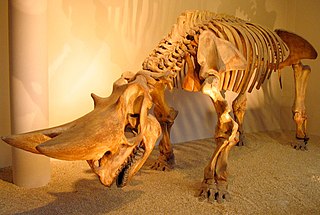Gondwanatherium is a genus of stem-mammal from the extinct suborder Gondwanatheria that lived in Patagonia, South America during the "Age of Dinosaurs", specifically during the Late Cretaceous.

Kollikodon is an extinct species of mammal, it is usually considered to be a member of Australosphenida and closely allied with monotremes, but is alternatively suggested to be a haramiyidan. It is known only from an opalised dentary fragment, with one premolar and two molars in situ, as well as a referred maxillary fragment containing the last premolar and all four molars. The fossils were found in the Griman Creek Formation at Lightning Ridge, New South Wales, Australia, as was Steropodon.

Steropodon galmani is a prehistoric species of monotreme, or egg-laying mammal, that lived about 105 million years ago (mya) in the Late Cretaceous period. It is one of the oldest monotremes discovered, and is one of the oldest Australian mammal discoveries.

Didelphodon is a genus of stagodont metatherians from the Late Cretaceous of North America.

Moeritherium is an extinct genus of primitive proboscideans. These prehistoric mammals are related to the elephant and, more distantly, sea cows and hyraxes. They lived during the Eocene epoch.

Arsinoitherium is an extinct genus of paenungulate mammals belonging to the extinct order Embrithopoda. It is related to elephants, sirenians, hyraxes and the extinct desmostylians. Arsinoitheres were superficially rhinoceros-like herbivores that lived during the late Eocene and the early Oligocene of northern Africa from 36 to 30 million years ago, in areas of tropical rainforest and at the margin of mangrove swamps. A species described in 2004, A. giganteum, lived in Ethiopia about 27 million years ago.

Deltatheridium is an extinct species of metatherian. It lived in what is now Mongolia during the Upper Cretaceous, circa 80 million years ago. It was a basal metatherian, which places it near to the start of the lineage that led to the marsupials, such as kangaroos, wallabies, koalas, and opossums.

Pucadelphys is an extinct genus of non-marsupial metatherian. The genus contains a single species, P. andinus. Fossils of Pucadelphys have been found in the Santa Lucía Formation in Tiupampa in Bolivia.

Vincelestes is an extinct genus of actively mobile mammal, that lived in what would be South America during the Early Cretaceous from 130—112 mya, existing for approximately 18 million years.
Lusitanisuchus is an extinct genus of mesoeucrocodylian crocodylomorph. Mostly fragmentary fossils have been found from several localities in Portugal and are Late Jurassic and Early Cretaceous in age.
Tinodon is an extinct genus of mammal alive 155-140.2 million years ago (Oxfordian-Berriasian) which has been found in the Morrison Formation, the Alcobaça Formation (Portugal) and the Lulworth Formation (England). It is of uncertain affinities, being most recently recovered as closer to therians than eutriconodonts but less so than allotherians. Two species are known: T. bellus and T. micron.

Paurodon is an extinct genus of Late Jurassic mammal from the Morrison Formation of the Western United States.

Laolestes is an extinct genus of dryolestid mammal. Remains are known from the Morrison Formation, in stratigraphic zones 5 and 6., the Late Jurassic of Portugal, and Early Cretaceous Wadhurst Clay of UK.

Dryolestes is an extinct genus of Late Jurassic mammal from the Morrison Formation and the Alcobaça Formation of Portugal. The type species Dryolestes priscus is present in stratigraphic zones 2, 5, and 6.
Euthlastus is an extinct genus of Late Jurassic mammal from the Morrison Formation. Present in stratigraphic zones 5 and 6. It is represented by only five upper molars.

Brancatherulum is an extinct genus of Late Jurassic mammal from the Tendaguru Formation of Tanzania. It is based on a single toothless dentary 21 mm in length. It is currently considered either a stem-zatherian or dryolestidan.

Henkelotherium is an extinct genus of mammal from the Late Jurassic (Kimmeridgian) Camadas de Guimarota, in Portugal. It differs from most other paurodontids in having more postcanine teeth.
Donodon is an extinct genus of mammal from the Early Cretaceous (?Berriasian) Ksar Metlili Formation of Talssint, Morocco. It differs from dryolestids in having upper molars that are not compressed mesiodistally. Recent studies suggest that it was closely related to various South American dryolestoids in the clade Meridiolestida. Specific similarities to Mesungulatum, a herbivorous mesungulatid, are noted.
Panamacebus is an extinct genus of monkey known from the Early Miocene of central Panama.
Groebertherium is a genus of dryolestoid mammal from the Late Cretaceous Los Alamitos and Allen Formations of Argentina. It is not closely related to other contemporary dryolestoids, all of which are part of the clade Meridiolestida.



















